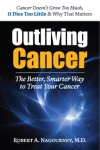Is There a Role for Maintenance Therapy in Cancer Treatment?
April 5, 2013 Leave a comment
There is a long tradition of maintenance therapy in pediatric oncology. Children with acute lymphoblastic leukemia uniformly receive three stages of therapy: induction, consolidation, and finally maintenance. The maintenance stage consists of weekly, or even daily therapies.
The historical experiences of relapse in this population lead investigators to consistently expose these patients to drugs for a period of years. Despite the apparent success of this approach in childhood cancers, long-term maintenance therapy did not gain popularity in adult oncology. Why?
There are probably several reasons. One reason is that childhood leukemia is among the most chemo-responsive diseases in medicine. As such, there are many active drugs available for treatment and many non-cross-resistant maintenance schedules that can be employed.
A second reason is the relative tolerability of drugs like oral thioguanine or mercaptopurine that are used in chronic maintenance therapy. By contrast adult tumors rarely achieve complete remissions. The number of active drugs has historically been very limited and the tolerance of long-term treatments characteristically poor.
Despite this, there is an appealing rational for maintenance therapy. Once we recognized and incorporated the tenents of apoptosis and programmed cell death into cancer management, we were forced to reconsider many of the principles of older treatment protocols.
Conceptually, maintenance allows for a cytotoxic exposure when the cell enters a “chemosensitive” period in its life cycle. Cancer cells that are “out surviving” their normal counterparts often do so in a quiescent stage (G0 Gx). In order to capture these cells, drugs must be present in the body when these cells awaken from their dormancy. As we have now achieved increasingly durable remissions in diseases like breast cancer, small cell lung and ovarian, we are confronting patients in long-term complete remission. When you add to this newfound population the availability of comparably mild agents, like the low dose Gemcitabine/Cisplatin doublet, we now have at our disposal active drugs that can be safely continued for long periods of time.
Using laboratory selection to identify first line (induction), second line (consolidation) and finally third line (maintenance) schedules, we can now offer our patients well-tolerated combinations that offer the hope of more durable remissions.
The GOG 178, in which continued taxol dosing provided more durable remission in ovarian cancer, provided the first inklings of this. Unfortunately, taxol is toxic. And the more durable remissions came at an increasingly high price: neuropathy, myelosuppression, alopecia, fatigue and malaise, which greatly limited the utility of this approach. Yet it does not limit its theoretical attractiveness as we continue to develop targeted agents with more selective activity and modified toxicity profiles. We anticipate maintenance therapies will become more widespread.
Based upon our experiences to date, we are successfully using this approach with our patients who achieve good clinical remissions.
You can find more information about our use of maintenance therapy, in Chapter 14 of the book Outliving Cancer.
This blog was originally posted in August 2011.



